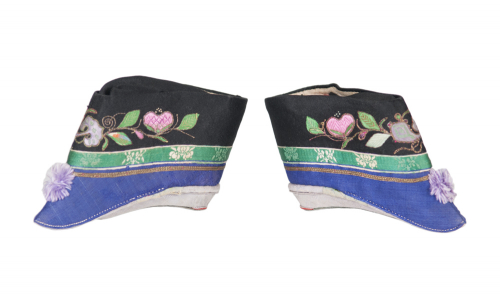
Slippers symbolise dark history

This coming week, Aotearoa New Zealand celebrates the Chinese language, so on behalf of MTG Hawke’s Bay we warmly wish you 身体健康, 幸福快乐 Shēntǐ jiànkāng, xìngfú kuàilè, (good health and happiness).
In 1967 Eunice Laura Preece, donated five Chinese artefacts to the Hawke’s Bay Museums Trust collection: a wooden and jade opium pipe, a jade, a child’s embroidered jacket and trousers, an art work on white silk depicting a Chinese procession and a pair of embroidered lotus slippers.
The acquisition certificate records that Eunice, a Māori missionary in China for over 30 years, had obtained these objects while stationed there. They reportedly came from the Peking Palace and had been removed during the Boxer Rebellion, 1899 – 1901.
It is difficult to know why Eunice gifted these Chinese items to the Hawke’s Bay Museums Trust, as she appeared to have no physical or emotional connection with the area. Eunice grew up in Coromandel and, in 1915, began her nursing training at the Auckland Hospital, graduating December 1920.
Through her close connection with the Church of England, she was accepted into the Society for the Propagation of the Gospel (SPG), a missionary organisation active in China from 1863 up to the middle of World War II. The Society was socially progressive, encouraging single women to train and work as missionaries and actively promoted women’s leadership roles in the medical, educational and evangelical fields.
In 1923, Eunice, under the banner of the SPG, set sail for China. She had been appointed nursing sister at the St Andrew’s Mission Hospital in the town of Hokien, 120 miles south-west of Peking. The hospital, built to house male patients only, was run by a European doctor and staffed by Chinese male nurses. A women’s hospital connected to St Andrews was subsequently built and Eunice became Matron in-charge of both.
In the spring of 1928, Kai Tiaki – the journal of the nurses of NZ recorded that, due to the tumultuous political unrest within China, Eunice’s work had become extremely difficult with the hospital having to cope with locals requiring attention, along with wounded soldiers.
To keep up with modern medical practices and techniques, Eunice was sent by the Society at the beginning of 1933 to re-train at a London Hospital. She returned to China in November bringing with her newly acquired knowledge and expertise as well as a selection of the latest medical instruments gifted by philanthropists.
Increasing turbulence continued in China between 1937 – 1943. Hokien was constantly bombed by the Imperial Japanese Army Air Service, but luckily the hospital remained intact. On 1 November 1943, the New Zealand Herald reported that Eunice Preece was interred, being held prisoner by the Japanese at the Civil Assembly Centre in Shanghai. How long she remained a prisoner, what her experiences were, and what happened next is unknown. When she gifted the five Chinese objects in 1967, she had returned to New Zealand and was living in Auckland.
The lotus slippers, in particular, are beautiful and exquisitely embroidered. Made of silk and only 76mm (three inches) long, these tiny slippers symbolise a very dark history of male subjugation towards women.
For over a thousand years’ tiny feet were symbols of feminine beauty, elegance, wealth and sexuality in China. A tiny lotus foot in its delicate silken shoe was seen as one of the most attractive qualities in a prospective bride. To achieve this desirable characteristic, a mother would begin binding her daughter’s feet from between the age of three and seven.
The ritual began with the young girl’s feet plunged into hot water perfumed with herbs, and the toenails trimmed. The feet and toes were massaged and oiled. All the toes except the big one, would then be broken and bound flat against the sole of the foot, making a triangular shape. Following this each foot was bent double and wrapped tightly in place, using either a silk or cotton strip (depending on the family’s wealth) of about ten feet long and two inches wide. Every week, for over two years, both feet would be unwrapped, washed and wrapped even tighter.
The tightening of the binding slowly broke the arches and created the desired shape. To hasten the breaking of the arches and reestablish circulation, the youngster was forced to walk long distances on her crushed feet. As the foot became shorter, the heel and toes were pulled closer together, turning the foot into a curved arc. The excruciating pain of foot-binding was exacerbated by infection, that sometimes led to gangrene, hindered circulation and weakened bones and ligaments.
As feet without the binding and embroidered slippers were unattractive, and often foul smelling from infection, they were never exposed to public view. Perfume, socks, leggings and lotus slippers were worn at all times, even in bed, to cover the damaged feet with beauty and delicacy.
Women with bound feet were almost helpless – they could hardly walk without assistance, much less work or help around the home. Wealthy married women lived sedate lives, often making and embroidering the very lotus slippers that kept them enslaved. In 1911, the Chinese Republic outlawed the practice, however it continued in remote rural areas until the People’s Republic of China began in 1949.
20 September 2020



